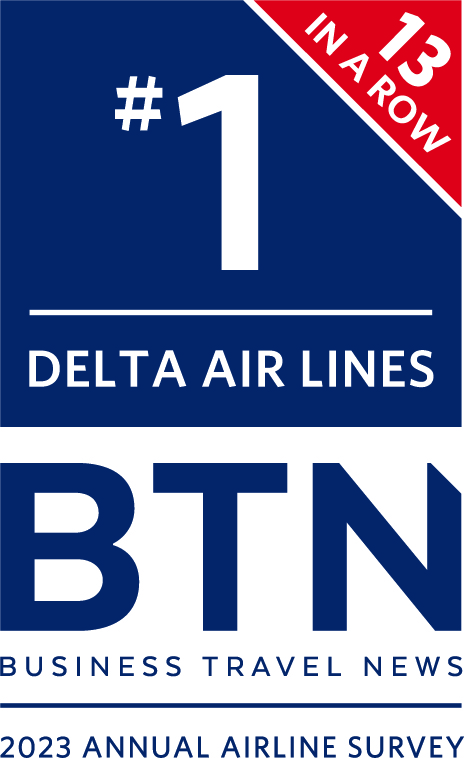
Wheelchair Services
General
Delta will accept for transportation, without charge, any manual or battery-operated mobility or assistive device. These assistive devices are not subject to excess baggage charges and checked baggage weight limits do not apply. Passengers with multiple wheelchairs or assistive devices must not be charged for any of the devices.
Customers are allowed to travel with spare batteries used to power the assistive device.
Please provide Delta with advance information regarding what type of wheelchair service is required by documenting the customer’s reservation with the appropriate SSR information.
Please note: To assist Delta in providing the best possible service for our customers with disabilities, please request the wheelchair service required, using the appropriate SSR, for ALL segments of the customer’s reservation, even if a customer only needs the wheelchair service for part of the itinerary.
SSR Code |
Description |
WCBD |
Wheelchair with dry cell battery to be transported by a passenger |
WCBW |
Wheelchair with wet cell battery to be transported by a passenger |
WCHC |
Wheelchair – cabin seat, completely immobile Requires wheelchair to/from aircraft.
|
WCHR |
Wheelchair – needed for long distance, meet at ramp Passenger can ascend/descend steps and make own way to/ from cabin seat, but requires wheelchair for distance to/from aircraft.
|
WCHS |
Wheelchair – cannot use steps Passenger cannot ascend/descend steps, but is able to make own way to/from cabin seat Requires wheelchair for distance to/from aircraft and must be carried up/down steps.
|
WCMP
|
Wheelchair – manual power to be transported by a passenger
|
WCOB
|
Onboard wheelchair - provided by airline
|
Please note: The MAAS SSR should only be used for a passenger with a disability if it is accompanied by a BLND, DEAF, or DPNA SSR. MAAS without an accompanying SSR is not a guaranteed service. If the customer requires wheelchair service please use the above SSRs.
- For questions regarding how to add the SSR to a customer’s reservation, please contact your GDS help desk for assistance.
- For assistance with specific required SSR documentation, please contact Global Sales Support or Delta Reservations.
General Questions for Customers with Disabilities
Customers worldwide with general questions or concerns regarding services for those traveling with a disability can contact Delta at 404-209-3434.
Airport Wheelchairs
Delta has wheelchairs available for use at airport locations. Request this service when making the customer’s reservation and advise the customer that upon arrival at the airport he or she should notify one of our Delta representatives that a wheelchair is required for transportation to the departure gate.
- Document the passenger’s reservation with the appropriate SSR for wheelchair service (WCHR, WCHS, or WCHC) to reflect the passenger's mobility.
- Example: SSRWCHRDLSS1**PSGR HAS OWN WHEELCHAIR
- Example: SSRWCHRDLSS1**PSGR HAS OWN WHEELCHAIR
Aisle Chairs
Delta also has a specially designed wheelchair available for our non-ambulatory passengers to use in reaching their seats when boarding and deplaning our aircraft. We call these special wheelchairs "aisle chairs" or "boarding chairs." Please request this service when making reservations to have the equipment available for the customer at the departure gate.
- Document the passenger’s reservation with the appropriate SSR for wheelchair service (WCHC) to reflect the passenger's mobility.
- Example: SSRWCHCDLSS1**PSGR REQUIRES AISLE CHAIR
On-board Wheelchairs
Every one of our mainline aircraft has an on-board wheelchair. These wheelchairs are specially designed to fit the aisle and may be used by passengers to move to and from the lavatory. Flight attendants are trained in the operation of this wheelchair and will assist the customer with its use. Flight attendants are not required to lift or carry a customer. Since this on-board wheelchair is not used outside the aircraft, it will always remain on board. Arrangements can be made for a customer to use an airport wheelchair at any connecting point.
Delta Connection® Carriers:
The CR7 aircraft (65 seats), CR9 aircraft (76 seats) and E170/ 175 are each equipped with an on-board wheelchair.
- Document the passenger’s reservation to request an on-board wheelchair
- Example: SSRWCOBDLSS1 **PSGR REQUIRES ON-BOARD WHEELCHAIR
Please note: On-board wheelchairs are not provided or accepted on any other Delta Connection carrier equipment.
Alternative Boarding Devices
In some instances stairways are used for boarding instead of loading bridges. Advise Delta if a customer is unable to ascend or descend steps and we will provide an alternative boarding method.
- Document the passenger’s reservation with the appropriate SSR for wheelchair service (WCHS) to reflect the passenger's mobility.
- Example: SSR WCHS DLSS1**PSGR CANNOT ASCEND OR DESCEND STEPS
Delta Electric Cart Service
In select cities, Delta offers electric cart service. Electric cart service cannot be reserved in advance and the frequency of electric cart service cannot be guaranteed. Please advise customers to arrive with enough time to access electric cart service and, if they need to make a connection, enough time to transfer to that connection.
Personal Wheelchair Services
Delta transports all types of personal wheelchairs on the same flight as the passenger, who is dependent on the device, including:
- Folding, collapsible and non-folding manual wheelchairs
- Electric/battery-powered wheelchairs and one additional wheelchair battery
- Electric-powered carts and scooters and one additional wheelchair battery
- Crutches, braces or other prosthetic devices
For customers that need to check any battery-powered equipment, Delta requires at least 48 hours advance notice. Please advise the customer to check in at the ticket counter at least one hour ahead of departure.
- Document the passenger’s reservation with the appropriate SSR for personal wheelchair service (WCMP, WCBD, or WCBW) to reflect what type of wheelchair the customer will be transporting.
- Example: 4SSRWCMPDLSS1**PSGR HAS SPORT WHEELCHAIR
Wheelchair Handling Form
It is helpful for your customer to print and fill out the My Wheelchair Handling Information form to accompany his or her wheelchair. Advise your customer to place the completed form in a plastic sleeve or laminate for repeated use. It can be placed in the seat of the wheelchair or attached to the back of the chair.
Cabin Stowage
Customers that have a collapsible personal wheelchair can ask to have it stowed on board when they are pre-boarded. Delta can stow a collapsible personal wheelchair if it meets the size and weight restrictions for the approved storage space on the aircraft. Not all aircraft stowage locations accommodate all sizes of wheelchairs. Wheelchairs stowed on board have priority over other carry-on items.
Please note: Battery-powered or electric scooter type wheelchairs are not allowed in the on-board stowage locations. These wheelchairs must be loaded in a cargo bin as checked or gate-checked (pink tag) baggage.
Checking a Wheelchair
A customer can check his or her wheelchair at the ticket counter or the gate and use Delta’s wheelchair equipment for travel within the airport.
We ask customers checking powered equipment that may require disassembly to check in at the ticket counter so we can arrange for proper handling. Detachable items, like seat cushions and footrests, can be carried on board or checked with the wheelchair in the cargo compartment.
Delta will not need to disassemble an electric/battery-powered wheelchair and will leave the batteries attached if the wheelchair will fit upright through the aircraft cargo compartment door or if it can be stowed upright in the cargo compartment.
If we do need to disassemble the wheelchair, our employees may need instructions. Please advise your customers to attach assembly/disassembly instructions and the wheelchair's specific battery type to the wheelchair. It is recommended that the customer complete the My Wheelchair Handling Information form to accompany his or her wheelchair. Advise your customer to place the completed form in a plastic sleeve or laminate for repeated use. It can be placed in the seat of the wheelchair or attached to the back of the chair.
Customers can arrange to have their personal wheelchair checked at the departing gate and returned at the destination gate upon arrival or at a connecting airport. Your customer should let us know at the airport in advance if he or she prefers to use his or her own personal wheelchair at the connecting airport. However, be aware that the time between connecting flights may be insufficient to provide this service during layover, especially if disassembly and re-assembly of the wheelchair is required. If time is a factor, we recommend that the customer takes advantage of Delta provided wheelchair service instead.
Federal Regulations
In most instances, Delta and Delta Connection Carriers will allow customers with battery-powered wheelchairs to check these assistive devices at the gate without having to disconnect the battery before transport. In order to transport a wheelchair or scooter without disconnecting the battery, your assistive device must possess a defect-free battery in a rigid compartment that is integral to the device. The equipment must also have two effective methods of preventing accidental activation during transport, including:
- Inserting charger (effectively disengages power to the battery)
- Turning key off, removing the key (note—the key may be required to transport the chair to the ramp for loading on the aircraft)
- Turning a kill switch
- Removing a power arm
- Taping a switch in closed position (see owner's manual if available)
There are still some circumstances that require that the battery be disconnected. For questions prior to travel, please contact Delta Reservations and ask to be connected to the CRO Desk. At the airport, ask any Delta Representative for assistance.
Batteries
Delta allows a customer to travel with a mobility/assistive device that requires batteries as well as spare batteries used to power such devices. Lithium Ion, Wet-Cell (spillable) and Dry-Cell or Gel (non-spillable) batteries are allowed as checked baggage.
Lithium Ion Batteries
Passengers are permitted to travel with lithium ion batteries that contain a maximum of 160 watt hours per battery. Any lithium ion battery containing more than 160 watt hours is prohibited from carriage on all passenger aircraft. Lithium ion batteries installed in a personal electronic device can be transported as checked or carry-on baggage. Lithium ion batteries not installed in a device (spares) must be in carry-on baggage. No more than 2 spares between 100 and 160 watt hours are allowed. For more information on traveling with batteries please review the DOT Safe Travel Tips and the supporting file for Acceptance Guidelines.
Lithium Ion Battery-Powered Mobility Devices
The Department of Transportation (DOT) requires that Delta allow customers to travel with lithium ion powered mobility devices within the federal restrictions listed below. For devices that are considered collapsible and the battery can be easily removed, customers will be allowed to carry on the mobility device battery as well as two spare batteries that power the mobility device for a total of three lithium ion batteries.
- Each battery must be less than 300 Watt per hour or contain less than 25 grams of Lithium content each.
- The battery terminals must be protected from short circuiting.
- The battery must have been tested per UN Part III, Section 38.3.
For mobility aids where the lithium battery is installed as an integral part of the device, there is no battery size limit. The mobility aid MUST have the battery protected from damage, the device “turned off” and it must be carried in the cargo compartment.
Spare Lithium Ion Batteries
Passengers are not permitted to pack loose lithium batteries in checked luggage. All spare lithium batteries not housed in electrical devices (i.e., cameras, camcorders, BlackBerry devices, cell phones, laptops, medical assistive devices, etc.) must be transported in carry-on baggage only. Spare alkaline batteries are still allowed to be transported in checked luggage and are not required to be carried on board.
Passenger carry-on baggage that is subsequently gate checked would be considered a checked bag prohibiting spare lithium batteries.
How to properly transport spare lithium batteries:
- Pack spare batteries in carry-on baggage.
- Keep spare batteries in the original retail packaging, to prevent unintentional activation or short-circuiting.
- If the original packaging is not available, effectively insulate battery terminals by isolating spare batteries from contact with other batteries and metal. Place each battery in its own protective case, plastic bag or package. Do not permit a loose battery to come in contact with metal objects, such as coins, keys or jewelry.
- Loose lithium batteries must have tape placed across the battery's contacts to isolate the terminals and prevent short circuiting.
- Take steps to prevent crushing, puncturing or putting a high degree of pressure on the battery, as this can cause an internal short-circuit, resulting in overheating.
For more information on traveling with batteries please review the DOT Safe Travel Tips and the supporting file for Acceptance Guidelines. .
Lithium Metal Batteries
Passengers are permitted to travel with lithium metal batteries that contain a maximum of two grams of lithium content per battery. Any lithium metal battery containing more than two grams of lithium is prohibited from transport on passenger aircraft. Lithium metal batteries installed in a device can be transported as checked or carry-on baggage. Lithium metal batteries not installed in a device (spares) are only permitted as carry-on baggage. Protective measures must be taken to prevent short circuits.
For more information on traveling with batteries please review the DOT Safe Travel Tips and the supporting file for Acceptance Guidelines.
Wet-cell - Spillable
Wet-cell batteries are considered spillable, so we need to make special preparations to transport them by air. We have to disconnect the battery and protect the terminals against electrical shorting. We have to remove the battery if we cannot fit your wheelchair equipment upright through the aircraft cargo compartment door. The battery will be shipped in Delta's battery box to meet all federal "dangerous goods" handling requirements. We cannot transport damaged or leaking batteries by air.
Dry-cell Non-spillable
Dry-cell and gel-cell batteries are considered non-spillable and have fewer requirements for handling. We can leave powered wheelchair batteries attached when the equipment fits upright. Delta personnel will need to know that a device can be stowed in the aircraft without accidental activation or they will be required to disconnect the battery post connectors and wrap each post connector with tape to prevent electrical shorts during shipping.
Aircraft Bin Doors Specifications
Due to the size of the aircraft bin doors on aircraft operated by Delta and our Delta Connection Carriers, some wheelchairs may not fit into the cargo compartment.
If you have a customer traveling with a wheelchair, use the Calculate Wheelchair or Assistive Device Fit tool , to determine whether their wheelchairs will fit into the cargo compartment, and provide their wheelchair dimensions (height x width x depth) to Global Sales Support or Delta Reservations, in advance, for inclusion in their reservation. To determine whether a wheelchair is within these specifications, removable parts such as footrests, headrests, cushions, removable armrests, etc. should be removed prior to measuring.
If a customer is traveling on a DL-Marketed/DL-Operated flight, travel agents may also add the dimensions to the PNR on behalf of the customer by using the Fly Delta app. To provide this information via the Fly Delta app, travel agents can:
- Go to "My Trips" and click on an existing reservation
- Within the reservation, select the "Accessible Services" tab
- Select, "Mobility Assistance"
- Select, "I'm bringing my personal assistive device"
- Enter additional information such as device dimensions and if assistance getting on/off the plane is required
- Save the request











